Effect of Processing Routes on Physical and Mechanical Properties of Advanced Cermet System
Abstract
:1. Introduction
2. Materials and Methods
3. Results and Discussion
4. Conclusions
Author Contributions
Funding
Data Availability Statement
Conflicts of Interest
References
- Peng, Y.; Miao, H.; Peng, Z. Development of Ti(CN)-based cermets: Mechanical properties and wear mechanism. Int. J. Refract. Met. Hard Mater. 2013, 39, 78–89. [Google Scholar] [CrossRef]
- Joardar, J.; Kim, S.W. Tribological Evaluation of Ultrafine Ti(CN) cermets. Mater. Manuf. Process. 2002, 17, 567–576. [Google Scholar] [CrossRef]
- Soboyejo, W. Special Issue—Materials and Manufacturing Processes on Multifunctional Micro- and Nano-Structures. Mater. Manuf. Process. 2007, 22, 139. [Google Scholar] [CrossRef]
- Kwona, W.T.; Park, J.S.; Kim, S.W.; Kang, S. Effect of WC and group IV carbides on the cutting performance of Ti(C,N) cermet tools. Int. J. Mach. Tools Manuf. 2004, 44, 341–346. [Google Scholar] [CrossRef]
- Ettmayer, P.; Kolaska, H.; Lengauer, W.; Dreyer, K. Ti(C,N) Cermets—Metallurgy and Properties. Int. J. Refract. Met. Hard Mater. 1995, 13, 343–351. [Google Scholar] [CrossRef]
- Shamanian, M.; Salehi, M.; Saatchi, A.; North, T.H. Influence of Ni Interlayers on the Mechanical Properties of Ti6Al4V/(WC-Co) Friction Welds. Mater. Manuf. Process. 2006, 18, 581–598. [Google Scholar] [CrossRef]
- Ahn, S.Y.; Kang, S. Formation of core/rim structures in Ti(C,N)-WC-Ni cermets via a dissolution and precipitation process. J. Am. Ceram. Soc. 2003, 83, 1489–1494. [Google Scholar] [CrossRef]
- Ahn, S.Y.; Kang, S. Effect of various carbides on the dissolution behavior of Ti(C0.7N0.3) in a Ti(C0.7N0.3)-30 Ni system. Int. J. Refract. Met. Hard Mater. 2001, 19, 539–545. [Google Scholar] [CrossRef]
- Zhang, S. Titanium carbonitride-based cermets: Processes and properties. Mater. Sci. Eng. A 1993, 163, 141–148. [Google Scholar] [CrossRef]
- Zhang, S.; Lu, G.Q. Sintering of Ti(C,N)Based Cermets: The Role of Compaction. Mater. Manuf. Process. 1995, 10, 773–783. [Google Scholar] [CrossRef]
- Yoo, S.H.; Sethuram, K.M.; Sudarshan, T.S. Apparatus for Bonding a Particle Materials to Near Theoretical Density. U.S. Patent 5,989,487, 23 November 1999. [Google Scholar]
- Yoo, S.H.; Sethuram, K.M.; Sudarshan, T.S. Method of Bonding a Particle Materials to Near Theoretical Density. U.S. Patent 6,001,304, 14 December 1999. [Google Scholar]
- Alvarez, M.; Sánchez, J.M. Spark plasma sintering of Ti(C,N) cermets with intermetallic binder phases. Int. J. Refract. Met. Hard Mater. 2007, 25, 107–118. [Google Scholar] [CrossRef]
- Ping, F.; Wei-hao, X.; Yong, Z.; Li-Xin, Y.; Yang-hua, X. Spark Plasma Sintering Properties of Ultrafine Ti (C, N)-based Cermet. J. Wuhan Univ. Technol. Mater. Sci. Ed. 2004, 19, 69–72. [Google Scholar] [CrossRef]
- Zheng, Y.; Wang, S.; You, M.; Tana, H.; Xiong, W. Fabrication of nanocomposite Ti(C,N)-based cermet by spark plasma sintering. Mater. Chem. Phys. 2005, 92, 64–70. [Google Scholar] [CrossRef]
- Srivatsan, T.S.; Manigandan, K.; Petraroli, M.; Trejo, R.M.; Sudarshan, T.S. Influence of size of nanoparticles and plasma pressure compaction on microstructural development and hardness of bulk tungsten samples. Adv. Powder Technol. 2013, 24, 190–199. [Google Scholar] [CrossRef]
- Yoo, S.; Kalyanaraman, R.; Subhash, G.; Sudarshan, T.S.; Dowding, R.J. High Strain Rate Response of PAS (Plasma Activated Sintering) Consolidated Tungsten Powders, Materials Modification, Inc. Available online: https://www.matmod.com/Publications/p2c_1.pdf (accessed on 1 October 2002).
- Shetty, D.K.; Wright, I.G.; Mincer, P.N.; Clauer, A.H. Indentation fracture of WC-Co cermets. J. Mater. Sci. 1985, 20, 1873–1882. [Google Scholar] [CrossRef]
- Park, S.; Kang, S. Toughened ultra-fine (Ti,W)(CN)–Ni cermets. Scr. Mater. 2005, 52, 129–133. [Google Scholar] [CrossRef]
- Jun, W.; Ying, L.; Yan, F.; Jinwen, Y.; Mingjing, T. Effect of NbC on the microstructure and sinterability of Ti(C0.7, N0.3)-based cermets. Int. J. Refract. Met. Hard Mater. 2009, 27, 549–551. [Google Scholar]
- Zhang, X.; Liu, N.; Rong, C. Effect of molybdenum content on the microstructure and mechanical properties of ultra-fine Ti(C, N) based cermets. Mater. Charact. 2008, 59, 1690–1696. [Google Scholar] [CrossRef]
- Zhang, H.; Dikeb, Y.; Tang, S. Preparation and properties of ultra-fine TiCN matrix cermets by vacuum microwave sintering. Rare Met. 2010, 29, 528–532. [Google Scholar] [CrossRef]
- Kim, Y.-S.; Kwon, W.T.; Seo, M.; Kang, S. Tool Performance of New Wear-resistant Cermets. Int. J. Precis. Eng. Manuf. 2012, 13, 941–946. [Google Scholar] [CrossRef]
- Jeon, E.T.; Joardar, J.; Kang, S. Microstructure and tribo-mechanical properties of ultrafine Ti(CN) cermets. Int. J. Refract. Met. Hard Mater. 2002, 20, 207–211. [Google Scholar] [CrossRef]
- Xiong, J.; Guo, Z.; Yang, M.; Shen, B. Preparation of ultra-fine TiC0.7N0.3-based cermet. Int. J. Refract. Met. Hard Mater. 2008, 26, 212–219. [Google Scholar] [CrossRef]
- Liu, Y.; Jin, Y.; Yu, H.; Ye, J. Ultrafine (Ti, M)(C, N)-based cermets with optimal mechanical properties. Int. J. Refract. Met. Hard Mater. 2011, 29, 104–107. [Google Scholar] [CrossRef]
- Jung, J.; Kang, S. Effect of ultra-fine powders on the microstructure of Ti(CN)–xWC–Ni cermets. Acta Mater. 2004, 52, 1379–1386. [Google Scholar] [CrossRef]
- Xiong, J.; Guo, Z.; Shen, B.; Cao, D. The effect of WC, Mo2C, TaC content on the microstructure and properties of ultra-fine TiC0.7N0.3 cermet. Mater. Des. 2007, 28, 1689–1694. [Google Scholar] [CrossRef]
- Zhu, G.; Liu, Y.; Ye, J. Influence of Ce–Co pre-alloyed powder addition on the microstructure and mechanical properties of Ti(C, N)-based cermets. Int. J. Refract. Met. Hard Mater. 2013, 37, 134–141. [Google Scholar] [CrossRef]
- Borrell, A.; Salvador, M.D.; Rocha, V.G.; Fernández, A.; Aviles, M.A.; Gotor, F.J. Bulk TiCxN1-x–15%Co cermets obtained by direct spark plasma sintering of mechanochemical synthesized powders. Mater. Res. Bull. 2012, 47, 4487–4490. [Google Scholar] [CrossRef]
- Gong, J.; Pan, X.; Miao, H.; Zhao, Z. Effect of metallic binder content on the microhardness of TiCN-based cermets. Mater. Sci. Eng. A 2003, 359, 391–395. [Google Scholar] [CrossRef]
- Liu, N.; Yin, W.; Zhu, L. Effect of TiC/TiN powder size on microstructure and properties of Ti(C, N)-based cermets. Mater. Sci. Eng. A 2007, 445–446, 707–716. [Google Scholar] [CrossRef]
- Zheng, Y.; Xiong, W.; Liu, W.; Lei, W.; Yuan, Q. Effect of nano addition on the microstructures and mechanical properties of Ti(C, N)-based cermets. Ceram. Int. 2005, 31, 165–170. [Google Scholar] [CrossRef]
- Liu, N.; Han, C.; Xu, Y.; Chao, S.; Shi, M.; Feng, J. Microstructures and mechanical properties of nano TiN modified TiC-based cermets for the milling tools. Mater. Sci. Eng. A 2004, 382, 122–131. [Google Scholar] [CrossRef]
- Xiong, J.; Guo, Z.; Wen, B.; Li, C.; Shen, B. Microstructure and properties of ultra-fine TiC0.7N0.3 cermet. Mater. Sci. Eng. A 2006, 416, 51–58. [Google Scholar] [CrossRef]
- Cardinal, S.; Malchère, A.; Garnier, V.; Fantozzi, G. Review Microstructure and mechanical properties of TiC–TiN based cermets for tools application. Int. J. Refract. Met. Hard Mater. 2009, 27, 521–527. [Google Scholar] [CrossRef]
- Yun, H.; Zou, B.; Wang, J. Effects of sintering temperature and nano Ti(C,N) on the microstructure and mechanical properties of Ti(C,N) cermets cutting tool materials with low Ni-Co. Mater. Sci. Eng. A Struct. 2017, 705, 98–104. [Google Scholar] [CrossRef]
- Zhang, G.; Huang, M.; Zhao, H.; Zhang, H.; Wang, Y.; Zhang, X.; Zheng, H.; Lu, P.; Zhao, Z. Investigation and properties of Ti(C,N)-based cermets with graphene nanosheet addition by spark plasma sintering. J. Mater. Res. Technol. 2023, 24, 185–199. [Google Scholar] [CrossRef]
- Yan, H.; Deng, Y.; Su, Y.Y.; Jiang, S.; Chen, Q.W.; Cao, S.X.; Liu, B. Ti(C, N)-Based Cermets with Two Kinds of Core-Rim Structures Constructed by β-Co Microspheres. Adv. Mater. Sci. Eng. 2020, 1–11, 4684529. [Google Scholar] [CrossRef]
- Shankar, E.; Prabu, S.B.; Padmanabhan, K.A. Mechanical properties and microstructures of TiCN/nano-TiB 2/TiN cermets prepared by spark plasma sintering. Ceram. Int. 2018, 44, 9384–9394. [Google Scholar] [CrossRef]
- Zhang, M.M.; Jiang, Y.; Lin, N.; Kang, X.Y.; Yan, Y.; Huang, J.H.; Liu, Y.; Qiu, S.; He, Y.H. Investigation of the oxidation behavior and high oxidation-resistant mechanism of Ti(C,N)-based cermets. Corros. Sci. 2020, 177, 108959. [Google Scholar] [CrossRef]
- De la Obra, A.G.; Sayagués, M.J.; Chicardi, E.; Gotor, F.J. Development of Ti(C,N)-based cermets with (Co,Fe,Ni)-based high entropy alloys as binder phase. J. Alloys Compd. 2019, 814, 152218. [Google Scholar] [CrossRef]
- Subin, A.J.; Merbin, J.; Menezes, P.L. Cermet Systems: Synthesis, Properties, and Applications. Ceramics 2022, 5, 210–236. [Google Scholar] [CrossRef]
- Comstock, G.J. Hard Cemented Carbide Material. U.S. Patent 2,033,513, 10 March 1936. [Google Scholar]
- Santrade, Ltd. Wear Resistant Alloy. U.S. Patent 4,145,213, 20 March 1979. [Google Scholar]
- Kennametal, Inc. Cermet Cutting Tool. U.S. Patent 4,942,097, 17 July 1990. [Google Scholar]
- Watanabe, T.; Doutsu, T.; Yagishita, O.; Yamamoto, H.; Kai, Y.; Agency of Industrial Science. Titanium Carbo-Nitride and Chromium Carbide-Based Ceramics Containing Metals. U.S. Patent 4,948,425, 14 August 1990. [Google Scholar]
- Isobe, K.; Nomura, T. Cermet Alloy Containing Nitrogen. U.S. Patent 5,186,739, 16 February 1993. [Google Scholar]
- Teruuchi, K.; Ueda, F.; Odani, N. Wear Resistant Titanium Carbonitride-Based Cermet Cutting Insert. U.S. Patent 5,370,719, 6 December 1994. [Google Scholar]
- Weinl, G.; Oskarsson, R.; Hultman, L. Titanium-Based Carbonitride Alloy with Controlled Structure. U.S. Patent 5,395,421, 7 March 1995. [Google Scholar]
- Nakamura, S.; Fujisawa, T.; Teruuti, K.; Tsujisaki, H.; Nonaka, M. Cutting Blade Made of Titanium Carbonitride-Base Cermet, and Cutting Blade Made of Coated Cermet. U.S. Patent 5,766,742, 16 June 1998. [Google Scholar]
- Rolander, U.; Weinl, G.; Lindahl, P.; Andren, H.O. Titanium-Based Carbonitride Alloy with Controllable Wear Resistance and Toughness. U.S. Patent 6,004,371, 21 December 1999. [Google Scholar]
- Iyori, Y.; Nakahara, Y.; Kimura, Y. TICN-Based Cermet. U.S. Patent 6,387,552 B1, 14 May 2002. [Google Scholar]
- Mitsubishi Materials Corp. Cermet Cutting Insert. European Patent Application EP 1,043,414 A1, 5 April 2000. [Google Scholar]
- Weinl, G.; Rolander, U.; Zwinkels, M. Ti(C,N)-(Ti,Nb,W)(C,N)-Co Alloy for Milling Cutting Tool Applications. U.S. Patent 7,332,122 B2, 19 February 2008. [Google Scholar]
- Lee, H.H.; Kim, K.H.; Shin, S.J.; Kim, S.M. Method for Producing Titanium Carbonitride Powder. European Patent EP3,181,274B1, 18 December 2019. [Google Scholar]
- Rolander, U.; Zwinkels, M.; Weinl, G. Ti(C,N)-(Ti,Nb,W)(C,N)-Co Alloy for Finishing and Semi finishing Turning Cutting Tool Applications. U.S. Patent 7,645,316 B2, 12 January 2010. [Google Scholar]
- Mitsubishi Materials Corp. Cermet Insert and Cutting Tool. U.S. Patent 8,007,561 B2, 30 August 2011. [Google Scholar]
- Banerjee, D. Cemented Carbide with Ultra-Low Thermal Conductivity. U.S. Patent 8,202,344 B2, 19 June 2012. [Google Scholar]

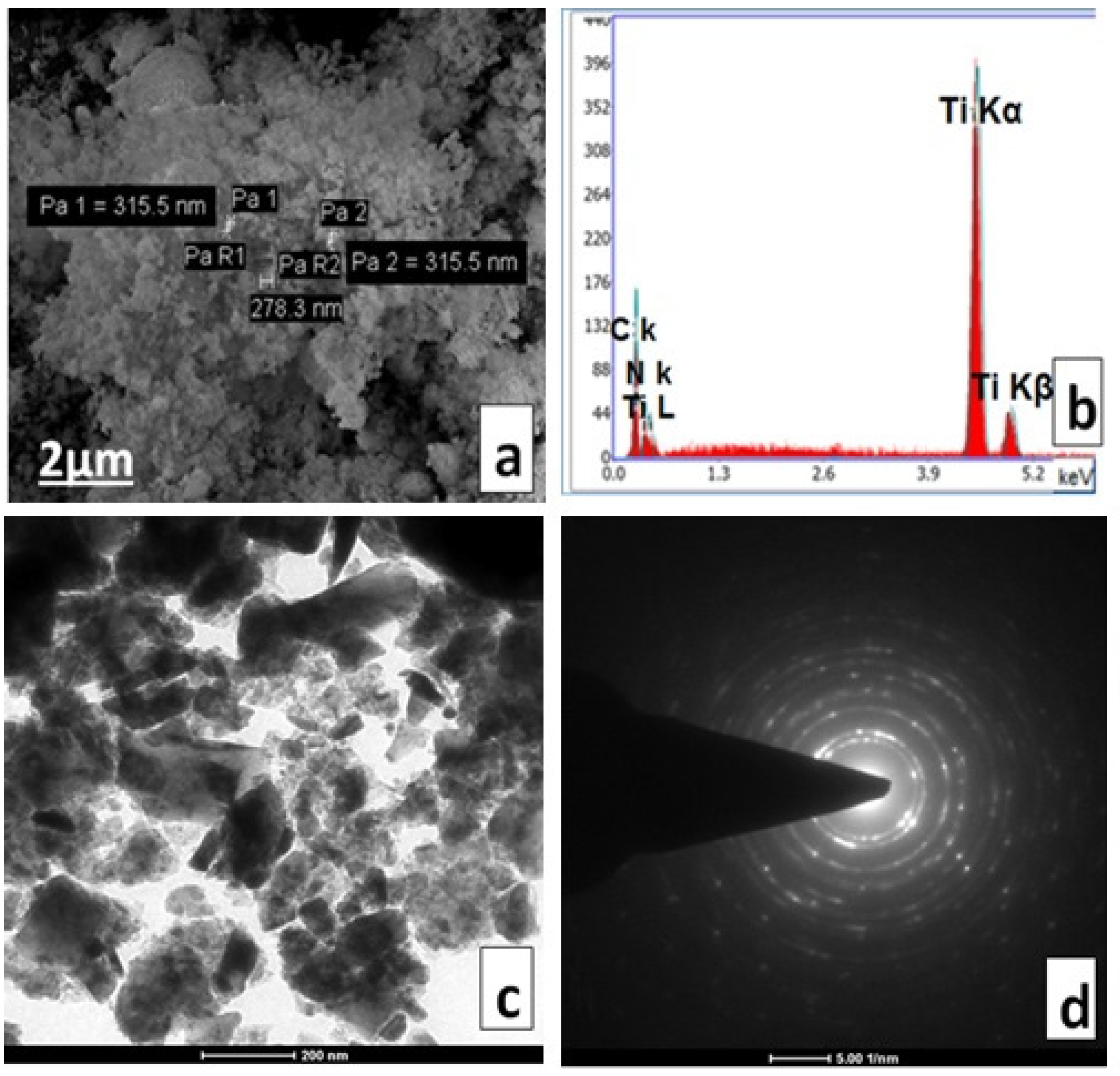
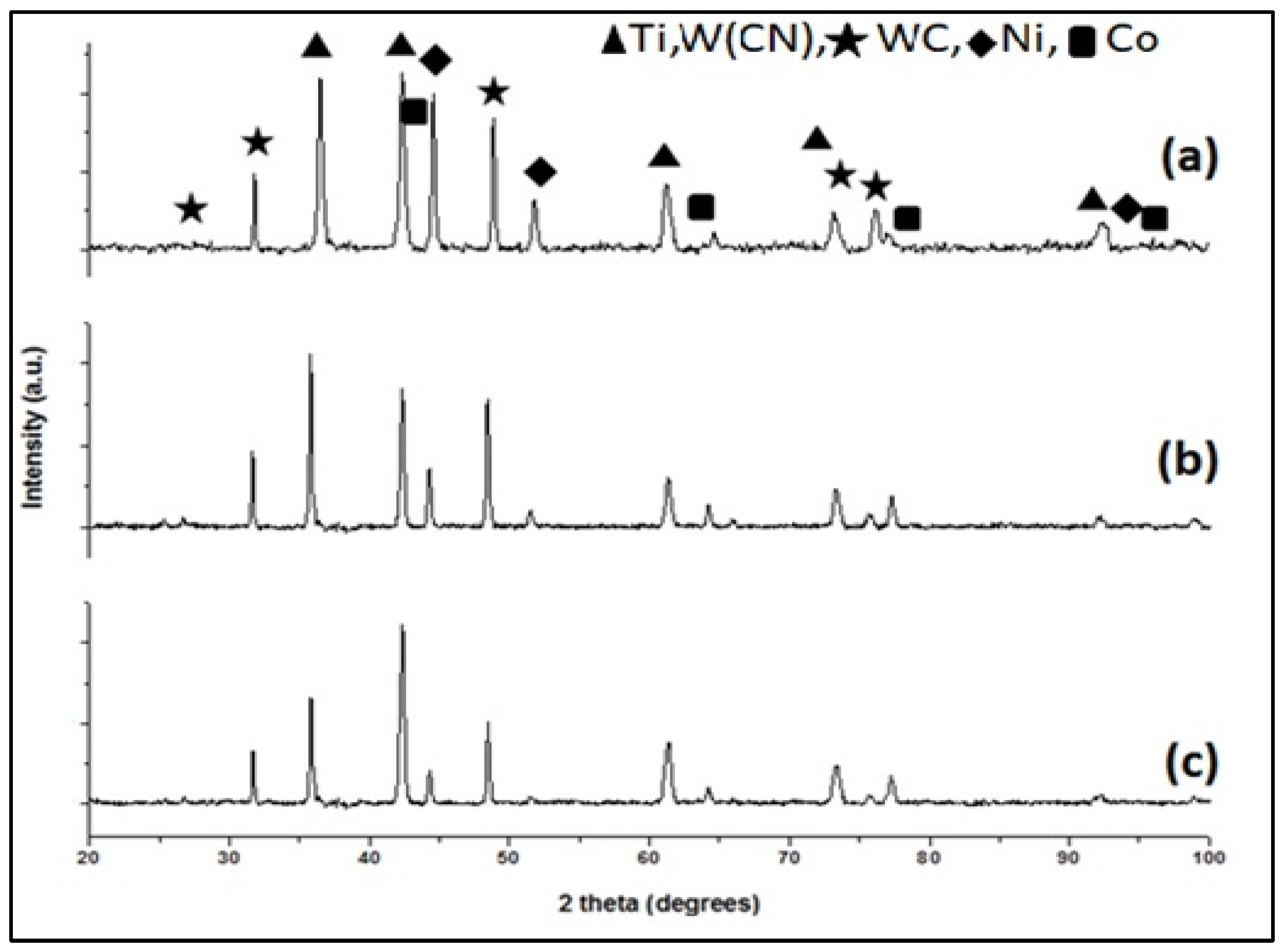
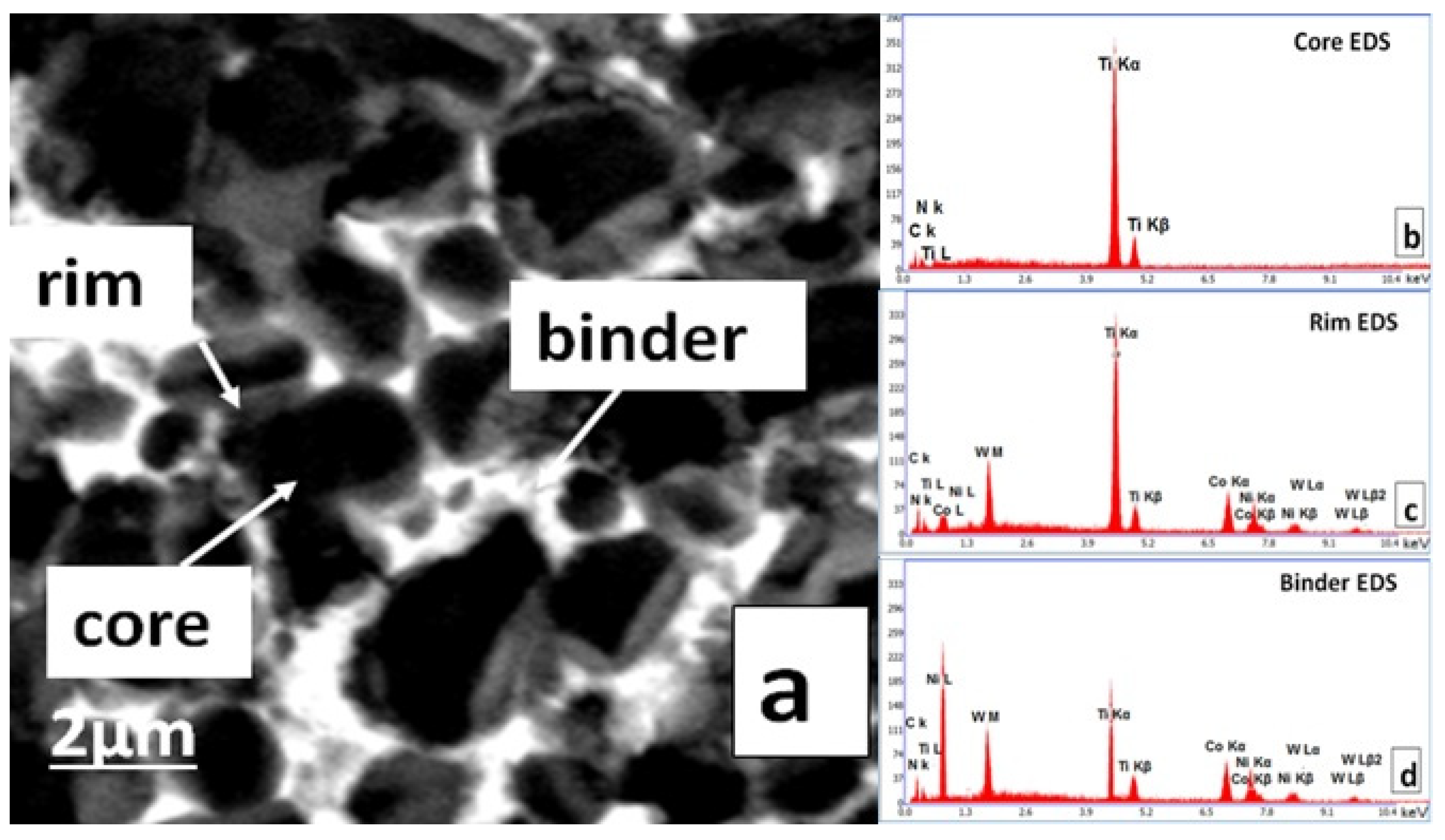
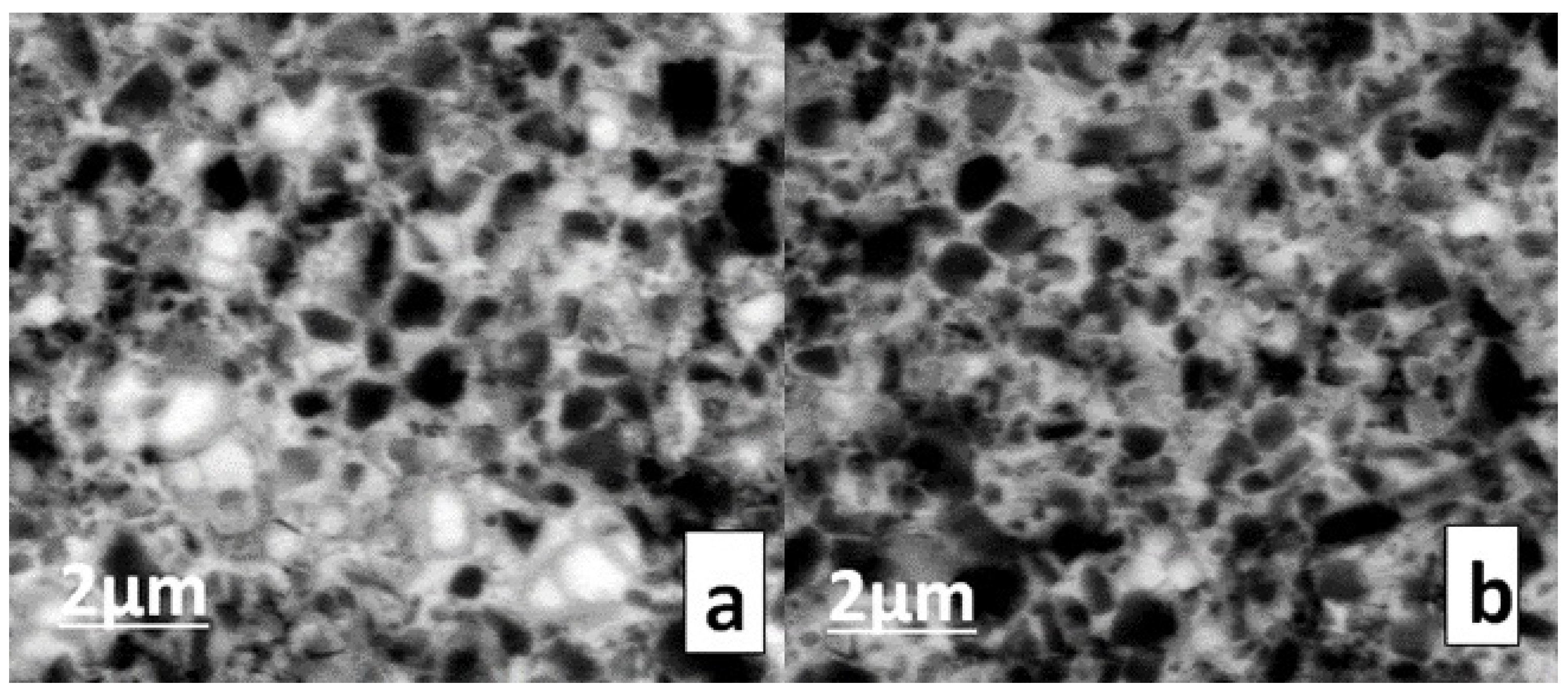
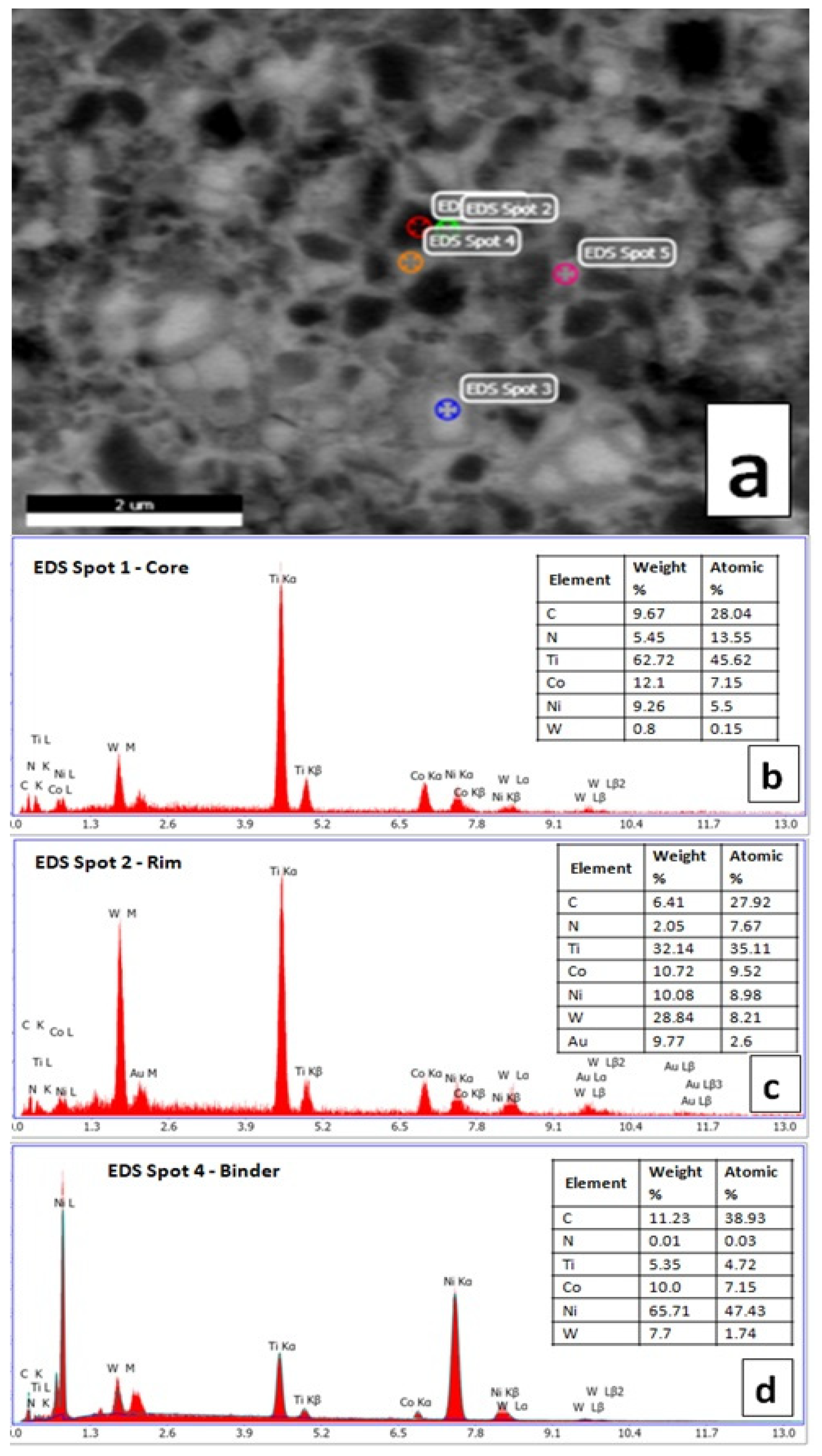
| Powder Info | Composition Info | Milling Parameters | Sintering | Paper Info (Year) | Ref. | ||||||
|---|---|---|---|---|---|---|---|---|---|---|---|
| TiCxN1-x, µm | X | WC, µm | Velo (RPM) | Time (h) | Tech Used | Pressure (MPa) | Sintering Temp | Holding Time (min) | |||
| >0.1 | 0.7 | 0.85 | TiCN-43,WC-6.9,Ni-32, Mo-16,VC-0.6,C-1.5 | 200 | 24 h | SPS | 20 | 1350 | 3 | 2004 | [15] |
| 3–4 | 0.5 | 1–4 | TiCN-65,WC-15,Ni-20 | 250 | 20 | VS | 150 | 1510 | 60 | 2004 | [19] |
| 1 | 0.7 | 0.8 | TiCN–WC–Mo2C–(Co,Ni) | - | 80 | VS | 100 | 1360 | 60 | 2008 | [20] |
| 0.1 | 0.5 | 1.14 | TiCN-(47.5–57.5),WC-20,Co-15,Mo-(5–15),C-2.5 | - | 24 h | VS | 170 | 1430 | 60 | 2006 | [21] |
| <1 | 0.7 | <1 | TiCN-59,WC-15,Co + Ni-17,Mo2C-9 | 304 | 50 h | VMS | 300 | 1400 | 5 | 2009 | [22] |
| 0.8–3 | 0.5 | 5.9 | TiCN-50,WC-21.22,Ni-20,{Mo + Ta(Nb)}-8.47 | - | 24 h | VS | 125 | 1510 | 60 | 2012 | [23] |
| 0.7–0.95 | 0.5 | 0.4 | TiCN-55,WC-25,Ni-20 | - | 24 h | VS | 100 | 1510 | 60 | 2001 | [24] |
| 0.13 | 0.7 | 0.45 | TiCN-53.5,WC-15,Co + Ni-14.5,TaC-7,Mo2C-10 | - | 45 h | VS | - | 1450 | 60 | 2008 | [25] |
| 0.5–0.8 | 0.5 | 200 nm | TiCN-51.87,WC-16,Ni-11,Co-9,Mo2C-12,VC-0.13 | 30 | 72 h | VS | 120 | 1450 | 90 | 2010 | [26] |
| 0.3 | 0.7 | 0.2 | TiCN-55,WC-25,Ni-20 | - | 24 h | VS | 100 | 1510 | 60 | 2003 | [27] |
| 0.13 | 0.7 | 0.45 | TiCN-X, Ni + Co-14.5,Mo2C-10, (WC-15/TaC-10) | 68 | 48 h | VS | - | - | 2006 | [28] | |
| 1 | 0.7 | 0.2 | TiCN-51.4,WC-15,Co + Ni-15,Mo2C-10,TaC-8,Ce/Co-0.6 | - | 72 h | VS | 100 | 1465 | 60 | 2012 | [29] |
| - | 0.5 | - | TiCN-85,Co-15 | 400 | 30 min | SPS | 80 | 1300 | 1 | 2012 | [30] |
| - | 0.5 | - | TiCN-80.75,Al2O3-14.25,Mo-2.5,Ni-2.5 | - | - | SPS | 50 | 1450 | 2 | 2003 | [31] |
| 0.7 | 0.8 | 3.52 | TiCN-65,WC-15,Ni-7.5,Co-7.5,Mo-4,C-1 | 150 | 24 h | VS | 180 | 1430 | 60 | 2006 | [32] |
| 1 | 0.7 | 0.72 | TiCN-43,WC-6.9,Ni-32,Mo-16,Cr3C2-0.6,C-1.5 | 150 | 12 h | VS | 300 | 1450 | 60 | 2004 | [33] |
| TiC-3.87, TiN-0.04 | 0.5 | 3.25 | TiCN-X,WC-15,Co + Ni-24, Mo-8/15, | - | 24 h | VS | 170 | 1450 | 60 | 2004 | [34] |
| 0.5 | 0.7 | 0.45 | TiCN-53.5,WC + TaC-22,Ni + Co-14.5,Mo2C-10 | 68 | 48 h | VS | - | - | 2005 | [35] | |
| TiC-1.5, TiN-2.9 | 0.5 | - | TiCN-70,Ni-20,Mo2C-10 | - | 24 h | VS | 100 | 1550 | 120 | 2008 | [36] |
| 0.21 | 0.7 | - | TiCN-76,Ni-12,Mo2C-12 | - | 36 h | SPS | 30 | 1250 | 3 | 2003 | [37] |
| Composition | Properties of Sintered Cermets | Ref. | |||||
|---|---|---|---|---|---|---|---|
| % Density | Relative Density (gm/cm3) | Grain Size (µm) | Hardness (GPa) | Fracture Toughness (MPa·m1/2) | Trans R.S. MPa | ||
| TiCN-76,Ni-12,Mo2C-12 | - | - | 0.42 | 16.78 | - | 295 | [14] |
| TiCN-43,WC-6.9,Ni-32,Mo-16,VC-0.6,C-1.5 | - | 6.48 | >100 nm | 14.2 | - | 879.5 | [15] |
| TiCN-65,WC-15,Ni-20 | 98.8 | 6.16 | 30–100 nm | 12.2 | 12 | - | [19] |
| TiCN–WC–Mo2C–(Co,Ni) | - | - | - | - | - | - | [20] |
| TiCN-57.5,WC-20,Co-15,Mo-5, C-2.5 | - | - | 1.17 | 15.98 | 13.2 | 870 | [21] |
| TiCN-52.5,WC-20,Co-15,Mo-10,C-2.5 | - | - | 1.15 | 17.39 | 11.9 | 990 | [21] |
| TiCN-47.5,WC-20,Co-15,Mo-15,C-2.5 | - | - | 0.79 | 17.87 | 11 | 1030 | [21] |
| TiCN-59,WC-15,Co + Ni-17,Mo2C-9 | 99.5 | - | >1 | 17.36 | - | - | [22] |
| TiCN-50,WC-21.22,Ni-20,{Mo + Ta(Nb)}-8.47 | - | - | 1–4 | ~11 | ~10 | - | [23] |
| TiCN-55,WC-25,Ni-20 | - | 6.5 | 0.7–0.9 | 14.2 | 8.8 | - | [24] |
| TiCN-53.5,WC-15,Co + Ni-14.5,TaC-7,Mo2C-10 | - | 6.39 | >1 | 17.54 | - | 965 | [25] |
| TiCN-51.87,WC-16,Ni-11,Co-9,Mo2C-12,VC-0.13 | 99.5 | 6.74 | 0.5–1 | 14.7 | 10.1 | 2210 | [26] |
| TiCN-55,WC-25,Ni-20 | - | - | 1.2 | 14 | 7.3 | - | [27] |
| TiCN-60.5,WC-15,Ni + Co-14.5,Mo2C-10 | - | - | 0.5 | 18.63 | - | 1500 | [28] |
| TiCN-75.5,Ni + Co-14.5,Mo2C-10 | - | - | 0.5 | 18.7 | - | 1320 | [28] |
| TiCN-50.5,WC-15,Ni + Co-14.5,Mo2C-10, TaC-10 | - | - | 0.5 | 18.65 | - | 1600 | [28] |
| TiCN-51.4,WC-15,Co + Ni-15,Mo2C-10, TaC-8, Ce/Co-0.6 | - | - | 1–2 | 17.06 | 9.21 | 1639 | [29] |
| TiCN-85,Co-15 | 99 | - | >1 | 17.1 | 5.51 | 904 | [30] |
| TiCN-80.75,Al2O3-14.25,Mo-2.5,Ni-2.5 | - | 5.115 | 0.5> | 14.45 | - | - | [31] |
| TiCN-65,WC-15,Ni-7.5,Co-7.5,Mo-4,C-1 | - | 6.258 | >1 | 18.63 | 14.5 | 1623.5 | [32] |
| TiCN-43,WC-6.9,Ni-32,Mo-16,Cr3C2-0.6,C-1.5 | 98> | - | >1 | 12.3 | - | 2884 | [33] |
| TiCN-53,WC-15,Mo-8,Co + Ni-24 | - | - | 1 | 12.5 | 17 | 1425 | [34] |
| TiCN-46,WC-15,Mo-15,Co + Ni-24 | - | - | 1 | 12.74 | 18.2 | 1600 | [34] |
| TiCN-53.5,WC + TaC-22,Ni + Co-14.5,Mo2C-10 | - | 6.7 | 0.3 | 19.5 | 10.6 | 1740 | [35] |
| TiCN-70,Ni-20,Mo2C-10 | >98 | 5.56 | 3.2 | - | 14.2 | - | [36] |
| S. No. | Patent Ref. | Filing Date | Publication Date | Applicant | Title | Ref. No. |
|---|---|---|---|---|---|---|
| 1 | US2033513 | 12 June 1935 | 10 March 1936 | Firth Sterling Steel Co. | Hard cemented carbide material | [44] |
| 2 | US4145213 | 17 May 1976 | 20 March 1979 | Sandvik Aktiebolag | Wear-resistant alloy | [45] |
| 3 | US4942097 | 14 October 1987 | 17 July 1990 | Kennametal Inc. | Cermet cutting tool (TiCN,WC,TiC,Mo2C,Co,Ni) | [46] |
| 4 | US4948425 | 6 April 1989 | 14 August 1990 | Agency of Industrial Science and Technology | Titanium carbo-nitride and chromium carbide-based ceramics containing metals (TiC.5N.5,Cr3C2,Mo2C,B4C,Co,Ni,Si) | [47] |
| 5 | US5186739 | 21 February 1990 | 16 February 1993 | Sumitomo Electric Industries, Ltd. | Cermet alloy containing nitrogen | [48] |
| 6 | US5370719 | 16 November 1993 | 6 December 1994 | Mitsubishi Materials Corporation | Wear-resistant titanium carbonitride-based cermet cutting insert (TiCN,WC,Cr3C2, Mo2C,ZrC,TaC,NbCN,VC,Ni,Co) | [49] |
| 7 | US5395421 | 30 September 1993 | 7 March 1995 | Sandvik Ab | Titanium-based carbonitride alloy with controlled structure (TiC,TiN,WC,Mo2C,TaC,VC,Co,Ni) | [50] |
| 8 | US5766742 | 31 October 1996 | 16 June 1998 | Mitsubishi Materials Corporation | Cutting blade made of titanium carbonitride-base cermet, and cutting blade made of coated cermet (TiCN,TiN,TaC,NbC,WC,VC,ZrC, Cr3C2,Mo2C,Co,Ni, graphite powder C) | [51] |
| 9 | US6004371 | 19 January 1996 | 21 December 1999 | Sandvik Ab | Titanium-based carbonitride alloy with controllable wear resistance and toughness (TiC,TiN,WC,Mo2C,TaC,VC,Co,Ni) | [52] |
| 10 | US 6,387,552 B1 | 21 September 2000 | 14 May 2002 | Hitachi Tool Engineering, Ltd., Tokyo (JP) | TiCN-Based Cermet (TiN,TiC,TiCN,WC,MoC,TaC,Ni,Co) | [53] |
| 11 | EP1043414A1 | 5 April 2000 | 11 October 2000 | Mitsubishi Materials Corporation | Cermet cutting insert | [54] |
| 12 | US7332122 | 7 October 2003 | 19 February 2008 | Sandvik Intellectual Property Ab | Ti(C,N)-(Ti,Nb,W)(C,N)-Co alloy for milling cutting tool applications | [55] |
| 13 | EP3 181 274B1 | 2 April 2015 | 18 December 2019 | Nano Tech Co., Ltd. | Method For Producing Titanium Carbonitride Powder (TiO2,Ca,C,N2) | [56] |
| 14 | US7645316 | 30 October 2006 | 12 January 2010 | Sandvik Intellectual Property Aktiebolag | Ti(C,N)-(Ti,Nb,W)(C,N)-Co alloy for finishing and semifinishing turning cutting tool applications | [57] |
| 15 | US8007561 | 13 June 2006 | 30 August 2011 | Ngk Spark Plug Co., Ltd. | Cermet insert and cutting tool | [58] |
| 16 | US 8202344 B2 | 21 May 2007 | 19 June 2012 | Kennametal Inc. | Cemented carbide with ultra-low thermal conductivity (TiC,WC,Cr3C2,TaNbC,Mo2C,Ni,Co) | [59] |
| Cermet (wt%): 75TiCN-10WC-15(Ni-Co) | ||||||
|---|---|---|---|---|---|---|
| Sintering Technique | Sintering Temp. (°C) | Holding Time (min) | Pressure (MPa) | Relative Density (%) | HV10 (GPa) | KIc (MPa m1/2) |
| Conventional | 1400 | 60 | 150-uniaxial 300-isostatic | ~98 | 15.0 ± 0.15 | 7.7 ± 0.45 |
| SPS | 1200 | 3 | 60 | >98 | 15.8 ± 0.23 | 8.0 ± 0.30 |
| 1250 | 3 | 60 | >98.5 | 16.3 ± 0.34 | 8.5 ± 0.21 | |
Disclaimer/Publisher’s Note: The statements, opinions and data contained in all publications are solely those of the individual author(s) and contributor(s) and not of MDPI and/or the editor(s). MDPI and/or the editor(s) disclaim responsibility for any injury to people or property resulting from any ideas, methods, instructions or products referred to in the content. |
© 2024 by the authors. Licensee MDPI, Basel, Switzerland. This article is an open access article distributed under the terms and conditions of the Creative Commons Attribution (CC BY) license (https://creativecommons.org/licenses/by/4.0/).
Share and Cite
Verma, V.; García-Hernández, M.; Luna-Domínguez, J.H.; Suárez-Domínguez, E.J.; Monteiro Júnior, S.; Câmara Cozza, R. Effect of Processing Routes on Physical and Mechanical Properties of Advanced Cermet System. Ceramics 2024, 7, 625-638. https://doi.org/10.3390/ceramics7020041
Verma V, García-Hernández M, Luna-Domínguez JH, Suárez-Domínguez EJ, Monteiro Júnior S, Câmara Cozza R. Effect of Processing Routes on Physical and Mechanical Properties of Advanced Cermet System. Ceramics. 2024; 7(2):625-638. https://doi.org/10.3390/ceramics7020041
Chicago/Turabian StyleVerma, Vikas, Margarita García-Hernández, Jorge Humberto Luna-Domínguez, Edgardo Jonathan Suárez-Domínguez, Samuel Monteiro Júnior, and Ronaldo Câmara Cozza. 2024. "Effect of Processing Routes on Physical and Mechanical Properties of Advanced Cermet System" Ceramics 7, no. 2: 625-638. https://doi.org/10.3390/ceramics7020041







